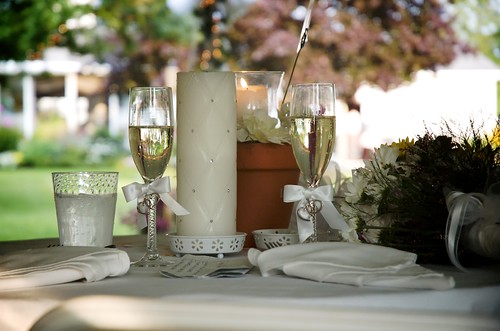
© 2009 Simon Hucko
I know I've drooled over RAW before, but I found a nice concrete example of why I'm never going back to JPEG while I was editing photos from this weekend.
I like today's shot. Nice color, pleasing bokeh, captures the feeling of sitting at the head table at a wedding. Out of the camera, it looked like this (straight RAW conversion):

© 2009 Simon Hucko
Underexposed, muddy, color is off - not such a nice shot. But, because I was shooting in RAW, I had some wiggle room and was able to save it. I set the white balance from one of the napkins, boosted the exposure, tweaked the levels to add some contrast, applied some noise reduction and sharpening, and added a little vignetting. Only a minute's worth of work, but it made a huge difference in the final product.
I try not to rely on this, but it certainly can help save a shot you like that's a little off.
__________________________________________________
Tip of the day: find something neutral in a picture to help set the white balance. Weddings are especially good for this because of all the white. (Just make sure that it's really white and not ivory/cream/champagne/whatever, or you'll have an unhappy bride on your hands)
~S
[title of blog] on flickr
![[title of blog]](https://blogger.googleusercontent.com/img/b/R29vZ2xl/AVvXsEhJ8bvx_9_zOAREbXcrJRML7aVvJMbb90IYYYuyti384jeZHYQ9t8MK6_Kpt_1P4-pZw-QfF9kh4Sqci0vbopzLme862PPhuyPJcc7pRLUW1K1aNzts5YzuXIhgonq66MpjJCqfiWtfwUw/s1600-r/waterfall.png)




Great reminder about finding something neutral in the photo.
ReplyDeleteAlthough I don't disagree at all on the use of RAW, you're missing out on why one should *not* do this in JPG...
ReplyDeleteIt's not so much that you shouldn't do it, as it is the degradation of image quality when you start to push/pull JPEG images. Even changing the white balance can negatively impact a JPEG image, whereas there's no penalty with RAW.
ReplyDeleteCould I have fixed this shot in JPEG? Probably. Would the colors in the background have been as rich and nice? Not sure. Would the shadow details have become overly noisy? Again, not sure.
Beyond the recovery possibilities, I also like being able to control the contrast and tone curve of the image, rather than being locked into whatever I had the camera set on.